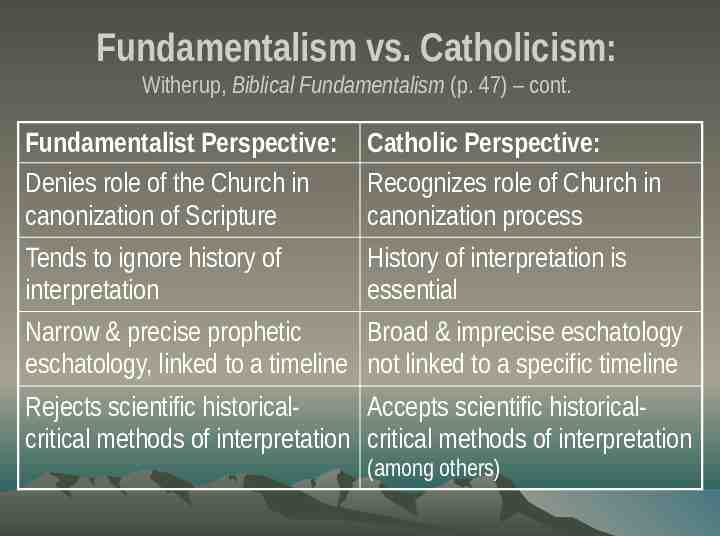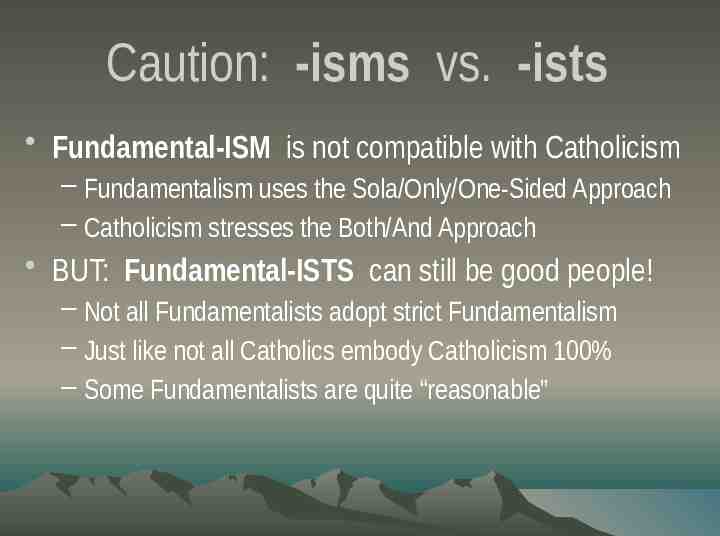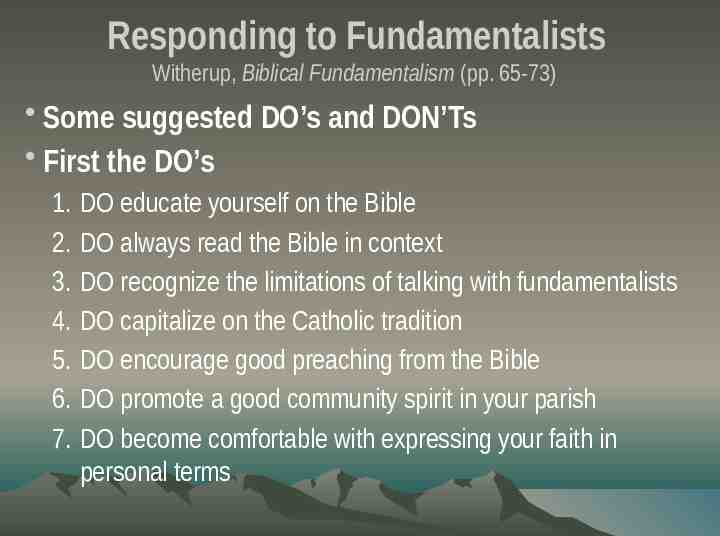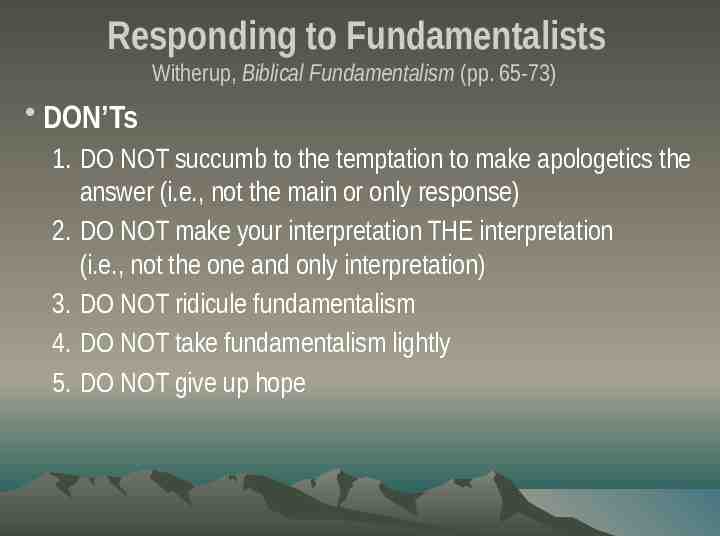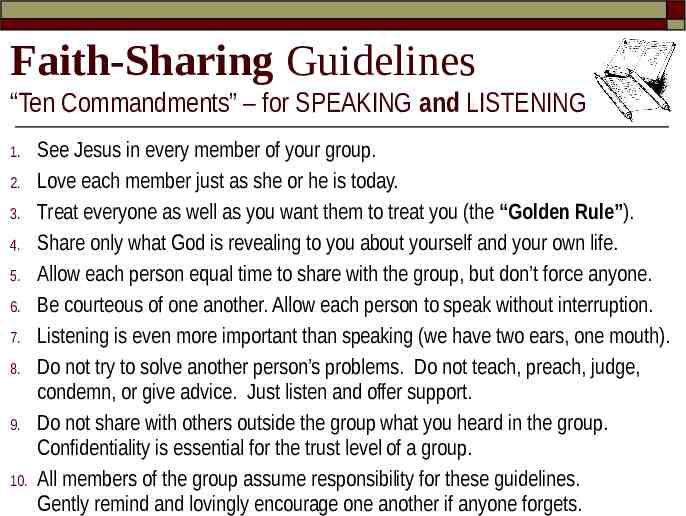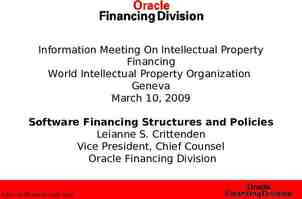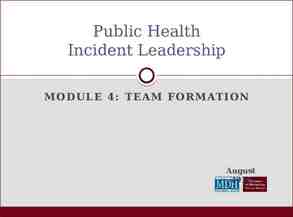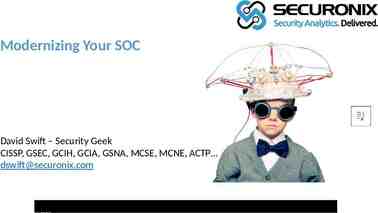WELCOME to CBISA – Year 3 Catholic Bible Institute of Southern Arizona
90 Slides1.06 MB

WELCOME to CBISA - Year 3 Catholic Bible Institute of Southern Arizona – Diocese of Tucson – September 12, 2020

Welcome to CBISA Year 3! Using ZOOM Easily and Well You control: Hosts control: Shared Screen (so you see my PPTs) Your Participation: Camera, Microphone, Volume settings Speaker View vs. Gallery View Chat Box, Open Mic, Breakouts Sign in at 8:45; Say hello in “Chat” (attendance) Put in your real name(s) Questions?

CBISA Year 3 – Today’s Schedule 8:45 Sign-in to ZOOM Session 9:00 Welcome & Opening Prayer (CBISA Leadership Team) Announcements – Registrations – Textbooks 9:15 Presentations (Fr. Felix) (with two 10-minute breaks, starting around 10:00 and 11:00) Year 3 Overview: Purpose, Adult Faith Formation, Team Projects Catholic Approach to Bible-Study/Scripture-Sharing Groups How to Read the Bible: Various Plans; Scripture Sharing Resources Parish Structures: Personnel & Ministries & Facilities Begin Organization of Spring Team Project 12:00 Lunch Break 1:00 Lectio Divina Introduction to Lectio Divina Sample Lectio Divina Session 2:00 Evaluation & Discussion of Lectio Divina Process 2:30 Final Announcements and Closing Prayer 2:45 Conclusion

Opening Prayer: Song: Your Words Are Spirit and Life, vv. 1 & 2 Reading: Joshua 1:1-8 Responsorial: Psalm 119 Intercessions Prayer Song: Your Words Are Spirit and Life, v. 3 https://www.youtube.com/watch?v kLtJbB0bWYs

Reading: Joshua 1:1-8 A Reading from the Book of Joshua: After Moses, the servant of the LORD, had died, the LORD said to Moses’ aide Joshua, son of Nun: “Moses my servant is dead. So now, you and the whole people with you, prepare to cross the Jordan to the land that I will give the Israelites. Every place where you set foot I have given you, as I promised Moses. All the land of the Hittites, from the wilderness and the Lebanon east to the great river Euphrates and west to the Great Sea, will be your territory. No one can withstand you as long as you live. As I was with Moses, I will be with you: I will not leave you nor forsake you. Be strong and steadfast, so that you may give this people possession of the land I swore to their ancestors that I would give them. Only be strong and steadfast, being careful to observe the entire law which Moses my servant enjoined on you. Do not swerve from it either to the right or to the left, that you may succeed wherever you go. Do not let this book of the law depart from your lips. Recite it by day and by night, that you may carefully observe all that is written in it; then you will attain your goal; then you will succeed.” The Word of the Lord. All: Thanks be to God.

Psalm 119 Refrain/All: Blessed are those whose way is blameless, who walk by the law of the Lord. Women: Blessed are those whose way is blameless / who walk by the law of the Lord. Blessed those who keep God’s testimonies / who seek him with all their heart. (Ref.) Men: They do no wrong / they walk in God’s ways. You have given them the command / to observe your precepts with care. (Ref.) Women: May my ways be firm / in the observance of your statutes! Then I will not be ashamed / to ponder all your commandments. (Ref.) Men: I will praise you with sincere heart / as I study your righteous judgments. I will observe your statutes / do not leave me all alone. (Ref.)

Opening Prayer: Intercessions That the Church may grow in unity and remember Christ’s call to love and serve one another, including the challenge to love our enemies and to serve the poorest among us. We pray to the Lord All: Lord, hear our prayer. That all world leaders may act with honesty, integrity, and compassion to those whom Jesus loves—especially the poor and alien, orphans and widows. We pray to the Lord All: Lord, hear our prayer. That God continue to bless our Catholic Bible Institute community, so that we may give witness by living in a way consistent with the faith we proclaim. We pray to the Lord All: Lord, hear our prayer. That God bless our families with stronger bonds of friendship, love, and peace. We pray to the Lord All: Lord, hear our prayer.

Opening Prayer: Conclusion Collect Prayer Leader: Merciful Lord, inspire us to read your Scriptures and to meditate upon them day and night. We beg you to give us real understanding of what we need, so that we in turn may put its precepts into practice. Yet, we know that understanding and good intentions are worthless, unless they are rooted in your graceful love. So we ask that the words of Scripture may be not just signs on a page, but also channels of grace into our heart. All: Amen. Song: Your Words Are Spirit and Life, v. 3

CBISA – Year 3 Syllabus TEXTBOOKS: Mestre, Gabriel. Pray with the Bible; Meditate with the Word: The Exciting World of Lectio Divina. ABS, 2013. Regan, Jane E. Forming a Community of Faith: A Guide to Success in Adult Faith Formation Today. New London, CT: Twenty-Third Publications, 2014. WEBSITES: Diocese of Tucson – https://diocesetucson.org/cbisa Overall schedule & administrative contacts Fr. Felix Just, SJ – https://catholic-resources.org/CBISA Syllabus, with Handouts & PPT Presentations

CBISA – Year 3 Syllabus CBISA YEAR 3 LEADERSHIP TEAM: Fr. Felix Just, SJ Sr. Lois Paha, OP Ofelia James Pam Coonan Randy Munsen FALL SESSIONS (Sept. – Dec.) Mornings: Presentations by Fr. Felix Afternoons: Small-Group Practice in Lectio Divina (& other scripture-sharing methods & programs)

CBISA – Year 3 Syllabus (cont.) SPRING TEAM PROJECTS (Jan. – April) Facilitate a Scripture Sharing project in your own parish, school, online, or other group setting – physically or virtually! Visit and evaluate at least one other Scripture Sharing project facilitated by other CBI participants. – again, physically or virtually! Write a brief summary/evaluation report for your own Scripture Sharing project. See the extra handout which explains the Team Project in more detail. Saturday, May 8, 2021 – Wrap-Up / Evaluation Session: Each individual submits all written summary/evaluation reports. Each team presents an oral summary of how your project went and what you learned in the process. (time & location TBD) Sunday, June 6, 2021 – Certification Ceremony; 2:30 PM Liturgy of Word; Conferral of Certificates, Reception (location TBD)

Year 3 “Team Projects” GOAL: Learning to Facilitate Small-Group Scripture Sharing Who? - teams of three (or at least two) With Whom? - recruit participants; about 8-12 people Where? - parish, school, colleagues, neighbors, online, etc. When? - almost any time (finish before May 8, 2021) How Long? - at least six 90-min sessions (or nine 60-min sessions) What? - choose biblical readings, books, or topic How? - Select resources; select Lectio Divina or similar approach; integrate prayer, reading, reflection, study, quiet, and sharing.

Year 3 “Team Projects” FALL: Planning your Team Project for the Spring Sept. 2020 – Form Project Teams Oct. 2020 – Begin Developing Your Project Plans Nov. 2020 – Develop Your Plans in More Detail Dec. 2020 – Finalize Plans for Your Team’s Project SPRING: Implementing your plans (Jan. – April) Actually conduct/facilitate a small Scripture-Sharing group May 8, 2021 – Wrap-Up / Evaluation Session Presenting your written & oral reports Sunday, June 6, 2020 – Certification Ceremony Place TBD, depending on COVID

CBISA “Certification” Requirements for being certified by the Diocese of Tucson: On-time attendance at all five Saturday sessions (Fall 2020 & May 2021). No more than one absence can be excused, and only for an emergency or very serious reason. On-time submission of all project-related written assignments. Evidence of incorporating the CBISA feedback in revising your project plans. Successful completion of the project planned and implemented by your team. Evidence of having learned and applied the course material: not just knowledge of the structure and content of the OT and NT, but also the availability of academic and pastoral scripture-sharing resources, the principles of “Catholic Biblical Interpretation,” the Lectio Divina process, project planning skills, group facilitation skills, conflict resolution skills, and related topics.

How to Read the Bible? Catholic Approaches to Biblical Interpretation Felix Just, S.J., Ph.D. Jesuit Biblical Ministries, Los Angeles, CA https://catholic-resources.org

Should Catholics read the Bible? Common Warning before Vatican II – DON’T read the Bible! Why Not? – Too dangerous! Too easy to misunderstand! – Just listen to what Sister or Father tells you about it. New Emphasis since just before Vatican II: – DO read the Bible, but humbly, carefully, prayerfully! How? – In Liturgy & Sacraments, communally & individually

A Key Question: Should Catholics Read the Bible Literally? – Do we accept the Literal Interpretation of the Bible? Answer: YES! (Are you surprised?) Distinctions: – “Literal” but not “literalistic” (not naively; not as fundamentalists) – “Literal” means “according to the letter” Bible is literature! – “Literally” AND “spiritually” (not either/or)

What Is “Fundamentalism”? Five “Fundamentals” of Christian Doctrine 1. 2. 3. 4. 5. (1890’s, Prot.) Literal Inerrancy of the Bible (interpreted 100% factually) Virgin Birth & Deity of Jesus Substitutionary Atonement (Jesus’ death) Bodily Resurrection of Jesus Imminent Return of Jesus Popular Appeal of Fundamentalism: – simplistic answers to complex questions – meaning of texts is obvious? – people crave certainty (don’t want ambiguity or complexity)

5 Principles of Catholic Biblical Interp. 1. “Incarnational Theology” Core (God’s Self-Revelation!) vs. bibliolatry, over-emphasis on Bible as text 2. “Both / And” Approach to Christian Theology vs. one-sided over-emphasis or neglect 3. “Ecclesial Guidance” for Proper Understanding vs. individualistic mis-interpretations 4. “Literary Genres” are Diverse/Complex vs. modernist / historicist assumptions 5. “Historical-Critical” Exegesis is Essential vs. fundamentalist / literalist fallacies

Principles of Catholic Interpretation (1) Incarnational Principle: God’s Self-Revelation “Revelation” God’s “self-communication” in/to world – In multiple stages: more and more explicit over time “Tradition” “passing on” God’s revelation to future – In multiple stages: gradually more explicit and established

Principles of Catholic Interpretation (1) Incarnational Theology is the Core & Climax “Word of God” is not just a book (Bible), but Jesus! – Jesus is the Pinnacle of God’s Self-Revelation to the World – “God sent his only-begotten Son ” (John 3:16) Incarnation: “The Word became Flesh ” (John 1:14) – Jesus of Nazareth both Son of God and Son of Mary – Word of God (God speaks, things happen; cf. Gen 1) – Word made Flesh (God speaks in human languages) – See New Testament Christology (FJ)

Principles of Catholic Interpretation (2) The “BOTH / AND” Approach is Foundational: – Applies to Theology in general, Scripture in particular – Heads/Tails, Positive/Negative, North/South Examples from Theology: – God is both transcendent and immanent – Jesus is both fully human and fully divine – The Eucharist is both a meal and a sacrifice Problems/Errors with One-Sided Over-emphases: – Ex: Blind people touching different parts of an Elephant

Principles of Catholic Interpretation (2) The “BOTH / AND” Approach is Foundational: – Bible is both the Word of God and authored by humans – Bible contains both Old Testament and New Testament – Bible is both studied academically and prayed liturgically – Bible is used both individually and communally – Bible has both literal and spiritual meanings (4-fold meaning) Caution: Read it literally (as literature of various types), but not literalistically (mere historical facts) – See “BOTH/AND: The Essential Key to Catholic Theology” (FJ)

Principles of Catholic Interpretation (3) “Ecclesial” Guidance is Necessary Jesus, Disciples, Holy Spirit, Church: – All came before the Bible was written and compiled! – The Church (guided by the Holy Spirit) created the Bible, not only vice-versa! Church community helps us understand the texts: – Homilies, Books, Courses, Bible Study, Scripture Sharing Groups, etc. – Personal interpretation should not conflict with Church Tradition – Popes and Bishops are the guarantors of the Church’s Tradition (assisted by theologians & exegetes)

Official Church Documents: Pope Pius XII: Divino Afflante Spiritu (1943) Second Vatican Council: Dei Verbum (1965) Pontifical Biblical Commission: – “Historical Truth of the Gospels” (1964) – “The Interpretation of the Bible in the Church” (1993) Catechism of Catholic Church (1994; 2nd ed. 1997) – In section on “The Profession of Faith” (par. 51-141) Pope Benedict XVI: Verbum Domini: “The Word of the Lord” (Post-synodal Apostolic Exhortation, 2010) [ Online versions of these and related documents - FJ]

Principles of Catholic Interpretation (4) Awareness of Literary Genres is Crucial: “GENRE” category or type of literature (or art, music, etc.) – characterized by a particular form, style, or content. Many publications contain multiple genres: – Ex: Newspapers have news articles, editorials, comics, obituaries, sports results, financial reports, classified ads, movie reviews, etc. The Bible is not just one “book,” but a whole “library” – It contains many different literary genres, not just “history” – See “An Introduction to Literary Genres & Form Criticism” (FJ)

Hebrew Bible Genres Myths & Legends (Genesis, parts of Exodus, Numbers, Deuteronomy) Legal Codes (Leviticus, parts of Exodus, Numbers, Deuteronomy) Genealogies (parts of Genesis, much of Numbers) Annals (Josh, Judges, 1 & 2 Samuel, 1 & 2 Kings, etc.) Prophetic Books (Isaiah, Jeremiah, Ezekiel, etc.) Psalms/Odes/Songs (Psalms) Prayers/Laments (Lamentations) Proverbs (Proverbs) Wisdom Literature (Job, Wisdom, etc.) Apocalypse (Daniel)

New Testament Genres Gospels (Mark, Matthew, Luke, John) Acts (Acts of the Apostles) Letters (esp. Paul's) Church Orders (1 Timothy, Titus) Testament (2 Timothy & 2 Peter) Homily/Sermon (Hebrews) Wisdom Collection (James) Epistles/Encyclicals (1 & 2 Peter) Apocalypse (Revelation to John) Many more sub-genres, esp. within the Gospels

What is “Truth”? There are different KINDS of “Truth”: – Historical: Pearl Harbor was bombed on Dec. 7, 1941. – Conventional: My name is Felix. – Scientific: The earth revolves around the sun. – Mathematical: 2 3 5 – Theological: God is love. All of these are “true” – but not all are “historical” – So, the whole Bible is true, but not all the Bible is historical!

Literary Genres - Applications Did God create the whole world in only six days? – What is the literary genre of Genesis 1? Was Jonah really in the belly of a whale for 3 days? – What is the literary genre of the Book of Jonah? Was Daniel really thrown into a Lion’s Den? – What is the literary genre of the Book of Daniel? Is the “Parable of the Vineyard Workers” really fair? – What is the literary genre of Jesus’ parables?

Principles of Catholic Interpretation (5) Historical-Critical Exegesis is Essential: Ex-egesis “leading out” (drawing the intended meaning out of the text) – Vs. eis-egesis (putting your own pre-formed opinions into the text) – “Critical” asking analytical questions (not just “critiquing”) Consider multiple levels of both Content and Context: – Historical / Literal Content & Spiritual / Theological Content – Historical Context (surrounding world) & Literary Context (surrounding text) Openness to Development (historical, literary, theological): – Development from oral preaching/tradition to written texts/scriptures – Growth in our understanding and application of texts over time

Principles of Catholic Interpretation (5) Results of Exegesis available to non-specialists: Study Bibles: – Catholic Study Bible, New Jerusalem Bible, HarperCollins SB Bible Dictionaries: – HarperCollins, Eerdmans, Anchor, Interpreter’s, etc. Bible Commentaries: – One-Vol: New Jerome BC, HarperCollins, Collegeville, etc. – Multi-Vol: Sacra Pagina, Anchor BC, many others

Principles of Catholic Interpretation (5) Biblical Exegesis shows Theological Developments, even within the Bible itself. For example: Polytheism (there are many gods, with different roles) Henotheism (our God is better than all other gods) Monotheism (there is one and only one true God) Trinitarian Monotheism (one God is Father, Son, Spirit)

Principles of Catholic Interpretation (5) Biblical Exegesis also shows Moral Developments: Ancient Cultures: escalating retribution – Strike back hard! If you kill one of us, we’ll kill ten of you! Hebrew Bible: limited retribution – “Eye for eye, tooth for tooth, life for life”? – Exod 21:23-24; Lev 24:19-20; Deut 19:21 – Literal meaning? Historical context? New Testament: NO retribution! – Matt 5:38-48 – turn the other cheek, love your enemies – Literal meaning? Modern application?

Summary / Review 1. “Incarnational Theology” Core (God’s Self-Revelation!) vs. bibliolatry, over-emphasis on Bible as text 2. “Both / And” Approach to Christian Theology vs. one-sided over-emphasis or neglect 3. “Ecclesial Guidance” for Proper Understanding vs. individualistic mis-interpretations 4. “Literary Genres” are Diverse/Complex vs. modernist / historicist assumptions 5. “Historical-Critical” Exegesis is Essential vs. fundamentalist / literalist fallacies

How to Read the Bible? Various Reading Plans Felix Just, S.J., Ph.D. Jesuit Biblical Ministries, Los Angeles, CA https://catholic-resources.org

How Catholics USE the Bible: As the Foundation for all Theology & Ethics: – Multiple Sources for Theology, not just the Scriptures – Also Tradition, Experience, Culture In Liturgical Proclamation: – Readings proclaimed at Eucharist & other Sacraments – Selections prescribed in the Lectionary for Mass For Prayerful Meditation: – By individuals and/or groups – Bible Study, Lectio Divina, etc. Which texts to choose?

Plans for Choosing Biblical Texts 1. Canonical Approach – In biblical order, from Genesis to Revelation 2. Christo-centric Approach – Selected books, focusing on Jesus 3. Thematic / Theological Approach – Selected texts, focusing on themes 4. Liturgical / Lectionary Approach – Readings used at Sunday & daily Mass

1) Canonical Approach Reading the whole Bible from beginning to end: – From the Book of Genesis to the Book of Revelation – Reading thirty or more minutes each day – Reading one or more chapters each day Various plans for reading the whole Bible: – Daily Scripture and Catechism Devotional 1-year plan, by the “Coming Home Network“ – How to Read the Bible Every Day: A Guide for Catholics 1-year, Probably 2-year, 3-year plans; by Carmen Rojas not the best method, esp. not for beginners – Old Testament (OT) is long and difficult; you might give up!

2) Christo-centric Approach Reading one book at a time, focusing on Jesus: – – – – Begin with one of the Gospels, for the basic story about Jesus. Maybe start with Mark, the oldest & shortest Gospel. Then read some NT letters, another Gospel, and Acts of the Apostles. Then read more NT letters and also some OT books. Read OT or NT books acc. to the Lectionary schedule. Many good commentaries to guide your study: – Collegeville Bible Commentary and New Collegeville Bible Commentary series – by The Liturgical Press. – Little Rock Scripture Study – by the Diocese of Little Rock, Arkansas, and The Liturgical Press. – Six Weeks with the Bible: Catholic Perspectives – by Loyola Press. – Denver Catholic Biblical School Program – by Paulist Press.

3) Thematic/Theological Approach Reading portions of the Bible that are related to some theological, ethical, spiritual, liturgical, or other theme. – For example, read texts related to the resurrection of Jesus – or texts related to an issue of social justice – or texts related to Mary or one of the saints. Booklets and guides on various biblical themes: – Threshold Bible Study – thematic studies presented in short workbooks; from Twenty-third Publications. – Scripture from Scratch – short flyers appropriate as bulletin inserts; from St. Anthony Messenger Press. – Interfaces – a new series of short commentaries on certain biblical characters; from The Liturgical Press.

4) Liturgical/Lectionary Approach Reading the short biblical selections that are used for daily and/or Sunday Mass, as found in the Lectionary. – Monthly booklets of liturgical readings, along with commentaries, prayers, and/or study aides: – Give Us This Day; Living with Christ; Magnificat; The Word Among Us; etc. – Readings for Mass on the US Catholic Bishops’ website: https://bible.usccb.org/ – See also the Lectionary for Mass section of my website: https://catholic-resources.org/Lectionary.

Bible Study Resources See HO on Threshold Bible Study (Stephen Binz) & Six Weeks with the Bible (Loyola Press) More details on resources next month

Which English Translation to Use? Many choices possible, none is “best” – Newest ones (1980’s or later) are generally better – Avoid older ones: King James Version or Douay-Rheims Good to use & compare several different translations – More literal : New American Bible (NAB), NRSV, etc. – More colloquial : New Jerusalem Bible (NJB), REB, etc. “Catholic” or “Ecumenical” Editions – With the “Apocrypha” or “Deuterocanonical Books” “Study Bible” Editions – With introductions, footnotes, maps, etc.

How Well Do You Know Your Parish? Personnel: Pastor / Administrator / PLD; Associate Pastors / Pastoral Associates Ministry Staff: DRE, AFF, Liturgy/Music, Social Service, etc. Support Staff: Business Manager, Receptionist, Maintenance, etc. Parish Volunteers: Parish Council, Catechists, Liturgical Ministers, etc. Parish School(?): staff, children, stability, facilities, parish interface Active Parishioners: # registered, attendees (weekly, annual), visitors Social Description: age range, ethnic makeup, economic levels, etc.

How Well Do You Know Your Parish? Ministries: Liturgy: Sundays & Weekdays Sacraments & Sacramental Preparation Religious Education for Children Adult Faith Formation (RCIA, more?) Social Groups; Service Outreach/Projects Other? Facilities: Church, Hall, Classrooms, Meeting Rooms Restrooms, Keys, Lights, Heater/AC, Audio-Visual, Parking Kitchen, Storage Rooms, Tables, Chairs, etc.

Event/Activity Logistics Planning: Think of all the basics: Who, what, where, when, how, why? Permissions & scheduling: avoid major conflicts/overlaps Teamwork, Collaboration, Partnership, Community! Communication, Communication, Communication! Publicity: Bulletin, flyers, pulpit announcements Work with/through existing groups Personal invitation is always best

Event/Activity Logistics Set-up: Furniture: type & arrangement (seats? tables? community atmosphere?) Refreshments (warm and/or cold, liquid and/or solid? before, during, after?) “Sacred Space” (separate or integrated? candles? icons/images/symbols?) “Resource Table” (books, pamphlets, flyers; free, to borrow, for sale?) Program: Stick to your schedule! Stick to your topic! But also: Be flexible! Be adaptable! Roles of facilitators & participants

Getting to Know the Lectionary How well do you know the structure of the liturgical year and the Lectionary/scripture readings? Official “Introduction” to the Lectionary (2nd edition, 1981): Chap. 5 explains rationale for reading selections for each liturgical season Available online at http://catholic-resources.org/Lectionary Overall Structure of the Lectionary (USA edition, 1998/2002): Vol. 1: Sundays (and major feasts, arranged by liturgical season) Vols. 2-3: Weekdays (Years I & II) and Sanctoral cycle (propers) Vol. 4: Commons, Rituals, Votives, Various Needs and Occasions Biblical Resources: Study Bibles, Commentaries, Dictionaries, Atlases, Concordances, etc. Lectionary-based guides, seasonal reflections, preaching aides, etc. More on all this at our November session.

Characteristics of Effective Facilitator Is Competent, Compassionate, and Courageous 2. Listens to Others with Understanding 3. Empowers Others to Use Their Gifts 4. Recognizes and Respects Individual Differences 5. Understands His or Her Role as Task- and Relationship-Oriented 6. Contributes Ideas and Suggests Solutions to Problems; but also Values the Ideas and Contributions of Others 7. Recognizes and Rewards Individual & Team Efforts 8. Encourages and Appreciates the Comments and Insights of Others 9. Includes Others in the Decision-Making Process 10. Acknowledges and Confronts Conflict in a Timely, Open Manner 11. Leads from the Front, Middle, and Back – As Needed 12. Helps the Group to Focus on the Goal/Vision, and Keeps the Group Going toward That Goal/Vision 1.

Find 20 Books of the Bible Someone showed me this story and remarked that there are twenty books of the Bible hidden here. He challenged me to find them. Sure enough, they’re all here. Still this thing is a lulu. Kept me looking so hard for the longest time. Some of you will get bogged down with the facts; others are hit by them like they were some kind of revelation. You may get in a jam, especially since the names are not capitalized and often leap the spaces between the words. This makes it a real job to find them, but it’ll provide a most fascinating few minutes for you. Yes, there are some really easy ones to spot, but don’t get a big head ‘cause truthfully you’ll soon figure that it would take most federal judges and preachers numbers of hours to find them all. I will admit that it usually takes a minister to find one of them, and that it is not uncommon for there to be loud lamentations when it is pointed out. One lady says that when she is confronted with puzzles like this, she brews a cup of tea to help her concentrate better. But then this gal is a real pro! Verbs, nouns, and all that stuff are her thing. See how well you can compete. Relax! There really are twenty names of Bible books in this story. If you fail to find them, there’s a penalty. You’ll have to go fly a kite, sit on a banana, hum the Battle Hymn of the Republic, or hose a dog (a mean one).

Enjoy Your Lunch Break! We’ll start again at 1:00 PM Either: leave computers on (camera & mic off) Or: logout, but log back in before 1:00 Print & read 1-page HO on Lectio Divina during the break (if you haven’t yet) Come back early for conversation, if you wish Answers to “Find 20 Books” given at 12:55

Find 20 Books of the Bible Mark Luke Kings Acts Revelation James Job Amos Esther Ruth Judges Preacher (Ecclesiastes)* Numbers Titus Lamentations Hebrews Proverbs Peter Nahum Hosea *Note: This is the “groaner,” since “Preacher” is only very rarely used as an alternate name for the Book of Ecclesiastes.

Find 20 Books of the Bible Someone showed me this story and remarked that there are twenty books of the Bible hidden here. He challenged me to find them. Sure enough, they’re all here. Still this thing is a lulu. Kept me looking so hard for the longest time. Some of you will get bogged down with the facts; others are hit by them like they were some kind of revelation. You may get in a jam, especially since the names are not capitalized and often leap the spaces between the words. This makes it a real job to find them, but it’ll provide a most fascinating few minutes for you. Yes, there are some really easy ones to spot, but don’t get a big head ‘cause truthfully you’ll soon figure that it would take most federal judges and preachers numbers of hours to find them all. I will admit that it usually takes a minister to find one of them, and that it is not uncommon for there to be loud lamentations when it is pointed out. One lady says that when she is confronted with puzzles like this, she brews a cup of tea to help her concentrate better. But then this gal is a real pro! Verbs, nouns, and all that stuff are her thing. See how well you can compete. Relax! There really are twenty names of Bible books in this story. If you fail to find them, there’s a penalty. You’ll have to go fly a kite, sit on a banana, hum the Battle Hymn of the Republic, or hose a dog (a mean one).

Praying with the Bible: Lectio Divina A Vital Encounter with the Lord: Not just Bible Study, nor religious discussion Not just for monks and religious, but for all believers Enlivening, existential, transformative, uniting By Individuals or Groups: Individual: use and adapt flexibly to one’s own needs/style Groups: provide regular pattern for openness and trust

Lectio Divina: Priority “The Church in America should give high priority to prayerful reflection upon the Sacred Scripture by all the faithful. This Bible reading, accompanied by prayer, is known in the tradition of the Church by the name Lectio Divina, a practice that should be encouraged among all Christians.” John Paul II, Ecclesia in America (1999), 31

Lectio Divina – Traditional 4 Steps 1. Lectio: Prayerful Reading What 2. Meditatio: Meditation/Reflection What 3. does this passage mean to me? Oratio: Responsive Prayer What 4. does this biblical passage say? is my prayerful response to God? Contemplatio: Contemplation/Silence Enter into God’s silence

Lectio Divina – Luke Dysinger, OSB Simplified explanation, published in monthly Give Us This Day, back pages: Read Ponder Pray Cf. http://www.saintandrewsabbey.com/Lectio Divina s/35.htm

Lectio Divina: Process (ABS) 1) Reading (lectio) – hearing God’s Word in the Bible 2) Meditation (meditatio) – reflecting on the meaning of the text 3) Prayer (oratio) – speaking with God in praise, thanks, petition 4) Contemplation (contemplatio) – silence, listening to God 5) Action (actio/operatio) – letting the encounter affect my life & work Flexibly adapt these steps, as needed, for individuals and groups

Lectio Divina: Sample – Mark 1:14-15 1) Reading (lectio) – hear/listen to God’s Word 2) Meditation (meditatio) – reflect on the meaning of the text 3) Prayer (oratio) – speak with God in praise, thanks, petition 4) Contemplation (contemplatio) – listen to God in your heart 5) Action (actio/operatio) – how does this text affect my life & work?

Mark 1:14-15 After John had been arrested, Jesus came to Galilee proclaiming the gospel of God: 15 "This is the time of fulfillment. The kingdom of God is at hand. Repent, and believe in the gospel." (NAB) 14 Now after John was arrested, Jesus came to Galilee, proclaiming the good news of God, 15 and saying, "The time is fulfilled, and the kingdom of God has come near; repent, and believe in the good news." (NRSV) 14

Lectio Divina: ABS Resources Encounter with the Bible / Encuentro con la Biblia: Manual to implement the Lectio Divina in your Parish. American Bible Society, 2005. Encounter with the Bible: Practice Book / Encuentro con la Biblia: Libro de practicas. American Bible Society, 2007. Mestre, Fr. Gabriel. Pray with the Bible, Meditate with the Word: The Exciting World of the Lectio Divina – A Manual for the Prayerful Reading of the Bible. New York: ABS, 2013. Also in Spanish: Rezar con la Biblia, meditar con la palabra: El apasionante mundo de la lectio divina – Manual para la lectura orante de la Biblia.

Lectio Divina: More Resources The Catholic Prayer Bible: Lectio Divina Edition. Paulist, 2010. Binz, Stephen J. Conversing with God in Scripture: A Contemporary Approach to Lectio Divina. Word Among Us, 2008. Paintner, Christine Valters and Lucy Wynkoop. Lectio Divina: Contemplative Awakening and Awareness. Paulist, 2008. Magrassi, Mariano. Praying the Bible: An Introduction to Lectio Divina. Liturgical Press, 1998. Pennington, M. Basil. Lectio Divina: Renewing the Ancient Practice of Praying the Scriptures. Crossroad, 1998.

Matthew 18:21-35 Peter approached Jesus and asked him, "Lord, if my brother sins against me, how often must I forgive? As many as seven times?" Jesus answered, "I say to you, not seven times but seventy-seven times. That is why the kingdom of heaven may be likened to a king who decided to settle accounts with his servants. When he began the accounting, a debtor was brought before him who owed him a huge amount. Since he had no way of paying it back, his master ordered him to be sold, along with his wife, his children, and all his property, in payment of the debt. At that, the servant fell down, did him homage, and said, 'Be patient with me, and I will pay you back in full.‘ Moved with compassion the master of that servant let him go and forgave him the loan. When that servant had left, he found one of his fellow servants who owed him a much smaller amount.

Matthew 18:21-35 He seized him and started to choke him, demanding, 'Pay back what you owe.' Falling to his knees, his fellow servant begged him, 'Be patient with me, and I will pay you back.' But he refused. Instead, he had the fellow servant put in prison until he paid back the debt. Now when his fellow servants saw what had happened, they were deeply disturbed, and went to their master and reported the whole affair. His master summoned him and said to him, 'You wicked servant! I forgave you your entire debt because you begged me to. Should you not have had pity on your fellow servant, as I had pity on you?' Then in anger his master handed him over to the torturers until he should pay back the whole debt. So will my heavenly Father do to you, unless each of you forgives your brother from your heart." The Gospel of the Lord.

Lectio Divina: Process (ABS) 1) Reading (lectio) – hearing God’s Word in the Bible 2) Meditation (meditatio) – reflecting on the meaning of the text 3) Prayer (oratio) – speaking with God in praise, thanks, petition 4) Contemplation (contemplatio) – silence, listening to God 5) Action (actio/operatio) – letting the encounter affect my life & work Flexibly adapt these steps, as needed, for individuals and groups

Framework for Prayer Periods All extended prayer experiences could be enhanced by a few simple steps of Preparation and Conclusion: Preparation – 4 brief steps Main Prayer Period – 30 to 60 minutes? Use any style or method you have chosen for your prayer: Lectio Divina, Ignatian Contemplation, Meditation, Rosary, Centering Prayer, Music/Singing, etc. Conclusion – 4 brief steps

Preparation for Biblical Prayer Four Brief Steps in Preparation: Choose an appropriate time and place for your period of prayer. Become aware that you are always in the presence of a loving God. Thank God for creating you, loving you, adopting you as God’s own child. Ask God for an increase in faith, hope, love, or any other grace you may need.

Conclusion of Biblical Prayer Four Brief Steps in Conclusion: Reflect back over what you have just experienced (key thoughts, feelings, interior movements). Thank God for giving you this time and opportunity to encounter and communicate with God. Speak aloud a short concluding prayer (the Lord’s Prayer, Hail Mary, or another favorite prayer). Recall when & where you will pray the next time, so you look forward to encountering

Prayer: Speaking with God (A.C.T.S. I) Adoration – Give praise and glory to God for all His love and wondrous works (Ps 148150) Contrition – With a penitent heart, ask God to forgive all your sins and failings (Ps 51, 123) Thanksgiving – Give thanks to God for all gifts and blessings you have received (Ps 100, 136) Supplication – Petition God for whatever you need, big or small, in humility and trust (Ps 5, 17) Intercession – Pray also for others, for their

Prayer: Listening to God God’s Self-Revelation to us – in many different ways: Natural World – God’s goodness & love are revealed to us in the beauty and marvels of nature. Human Life – God can speak to us through art, music, literature, and everyday conversations. Sacred Scripture – God’s Word teaches and inspires us, comforts and challenges us each day. Interior Silence – We can encounter God

Closing Prayer (HO) Reading: Deuteronomy 4:1-2, 6-8 Pause for Silent Reflection on the Reading. Response: Psalm 119 Prayers of Thanksgiving Share Aloud Some Very Brief Prayers of Gratitude with the Other Members of Your Table Group. Concluding Prayer Closing Song: Your Words Are Spirit and Life, v. 4

Reading: Deut 4:1-2, 6-8 Reader: A reading from the Book of Deuteronomy. Moses said to the people: “Now, Israel, hear the statutes and decrees which I am teaching you to observe, that you may live, and may enter in and take possession of the land which the LORD, the God of your fathers, is giving you. In your observance of the commandments of the LORD, your God, which I enjoin upon you, you shall not add to what I command you nor subtract from it. Observe them carefully, for thus will you give evidence of your wisdom and intelligence to the nations, who will hear of all these statutes and say, ‘This great nation is truly a wise and intelligent people.’ For what great nation is there that has gods so close to it as the LORD, our God, is to us whenever we call upon him? Or what great nation has statutes and decrees that are as just as this whole law which I am setting before you today?” The Word of the Lord. All: Thanks be to God. Pause for a minute, for Silent Reflection on the Reading.

Psalm Response: Psalm 119 ALL: Lovers of your law have much peace; / for them there is no stumbling block. Men: Seven times a day I praise you, / because your judgments are righteous. Women: I look for your salvation, LORD, / and I fulfill your commandments. Men: I observe your testimonies; / I love them very much. Women: I observe your precepts and testimonies; / all my ways are before you. ALL: Lovers of your law have much peace; / for them there is no stumbling block.

Closing Prayer Prayers of Thanksgiving Concluding Prayer (All) Speak aloud some very brief prayers of gratitude for anything you wish to share with us all. Let your Scriptures be my chaste delight O Lord, perfect me and reveal those pages to me! See, your voice is my joy. Give me what I love May the inner secrets of your words be laid open to me when I knock. This I beg by our Lord Jesus Christ, in whom are hidden all the treasures of wisdom and knowledge. These are the treasures I seek in your books. Amen. Closing Song: Your Words Are Spirit and Life, v. 4

Go in Peace! Come back in Oct! Reading Assignments: Team Project Assignments Mestre, chaps. 5 & 6 Regan, chaps. 1 & 2 Sept. 19: Email Fr. Just w/ basic project info See you on Oct. 10: Go in the Peace of Christ!

Biblical Interpretation: Fundamentalism vs. Scientific / Historical / Catholic Approaches to the Bible Felix Just, S.J., Ph.D. http://catholic-resources.org

Fundamentalist Biblical Interpretation Sola Scriptura – Bible is the sole authority – – – – – Bible contains all we need for life Bible plainly says what it means, and means what it says Bible is inerrant: it contains no errors of any kind Bible authority remains valid for all time, for all people Bible prophecy is intended primarily for our own time Critique: Is “sola scriptura” a biblical doctrine? – Where in the Bible itself does it say that all life, all religion, everything should be based only on the Bible?

Fundamentalism vs. Catholicism: Ronald D. Witherup, Biblical Fundamentalism (p. 47) Fundamentalist Perspective: The Bible is the Word of God Scripture alone Catholic Perspective: The Bible is God’s Word in human words Scripture and Tradition Emphasis on literalist reading of the Bible Tends to view inspiration narrowly Emphasis on literal (not literalist) reading and deeper meanings Tends to take a broad view of inspiration

Fundamentalism vs. Catholicism: Witherup, Biblical Fundamentalism (p. 47) – cont. Fundamentalist Perspective: Inerrancy of the Bible in all matters Lack of historical perspective in interpretation Frequent interpretations out of context Direct & immediate applicability of most biblical passages Catholic Perspective: No errors in the Bible only on matters of faith & morals Historical perspective is essential for interpretation Need interpretations in context, esp. the context of the canon Mostly indirect applicability of biblical passages

Fundamentalism vs. Catholicism: Witherup, Biblical Fundamentalism (p. 47) – cont. Fundamentalist Perspective: Denies role of the Church in canonization of Scripture Catholic Perspective: Recognizes role of Church in canonization process Tends to ignore history of interpretation History of interpretation is essential Narrow & precise prophetic Broad & imprecise eschatology eschatology, linked to a timeline not linked to a specific timeline Rejects scientific historicalAccepts scientific historicalcritical methods of interpretation critical methods of interpretation (among others)
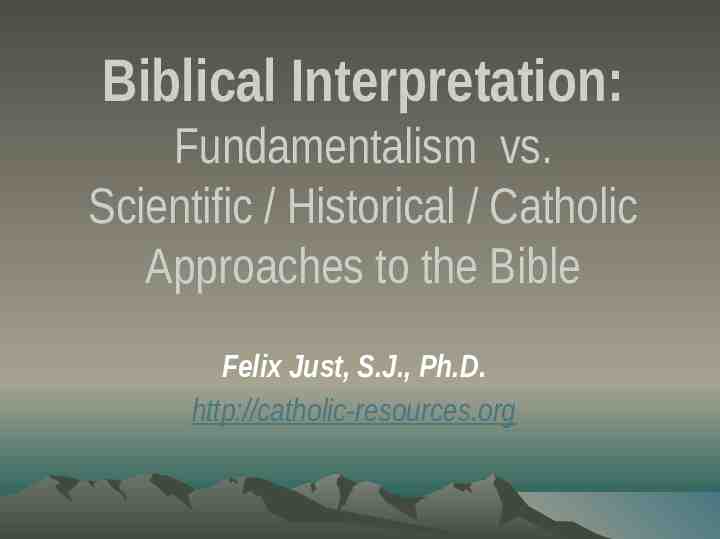
Caution: -isms vs. -ists Fundamental-ISM is not compatible with Catholicism – Fundamentalism uses the Sola/Only/One-Sided Approach – Catholicism stresses the Both/And Approach BUT: Fundamental-ISTS can still be good people! – Not all Fundamentalists adopt strict Fundamentalism – Just like not all Catholics embody Catholicism 100% – Some Fundamentalists are quite “reasonable”
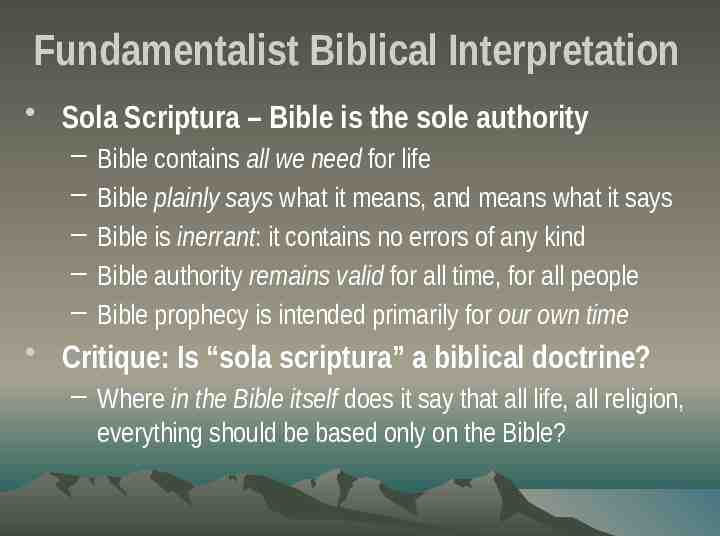
Responding to Fundamentalists Witherup, Biblical Fundamentalism (pp. 65-73) Some suggested DO’s and DON’Ts First the DO’s 1. DO educate yourself on the Bible 2. DO always read the Bible in context 3. DO recognize the limitations of talking with fundamentalists 4. DO capitalize on the Catholic tradition 5. DO encourage good preaching from the Bible 6. DO promote a good community spirit in your parish 7. DO become comfortable with expressing your faith in personal terms
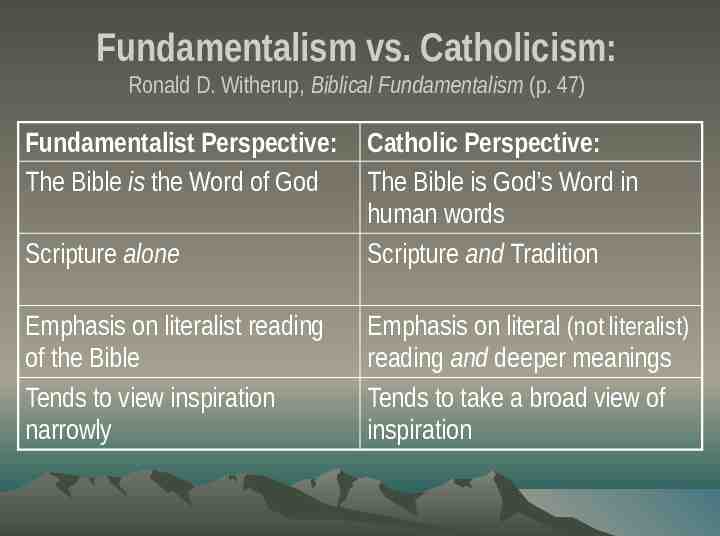
Responding to Fundamentalists Witherup, Biblical Fundamentalism (pp. 65-73) DON’Ts 1. DO NOT succumb to the temptation to make apologetics the answer (i.e., not the main or only response) 2. DO NOT make your interpretation THE interpretation (i.e., not the one and only interpretation) 3. DO NOT ridicule fundamentalism 4. DO NOT take fundamentalism lightly 5. DO NOT give up hope
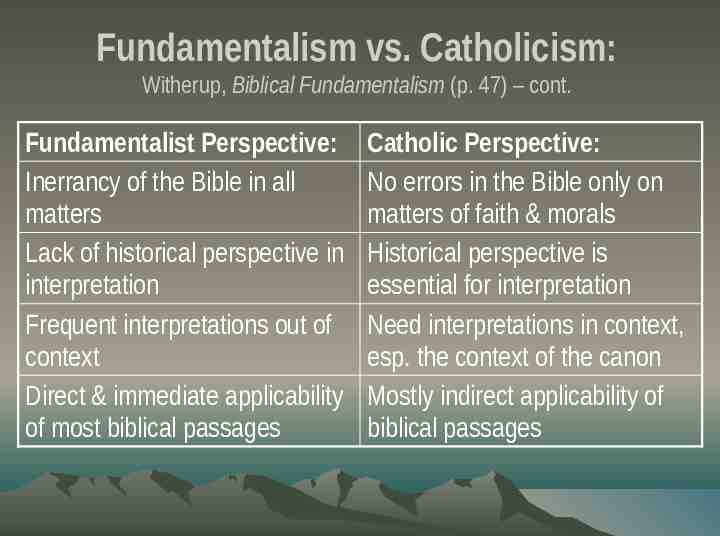
Faith-Sharing Guidelines “Ten Commandments” – for SPEAKING and LISTENING 1. 2. 3. 4. 5. 6. 7. 8. 9. 10. See Jesus in every member of your group. Love each member just as she or he is today. Treat everyone as well as you want them to treat you (the “Golden Rule”). Share only what God is revealing to you about yourself and your own life. Allow each person equal time to share with the group, but don’t force anyone. Be courteous of one another. Allow each person to speak without interruption. Listening is even more important than speaking (we have two ears, one mouth). Do not try to solve another person’s problems. Do not teach, preach, judge, condemn, or give advice. Just listen and offer support. Do not share with others outside the group what you heard in the group. Confidentiality is essential for the trust level of a group. All members of the group assume responsibility for these guidelines. Gently remind and lovingly encourage one another if anyone forgets.
